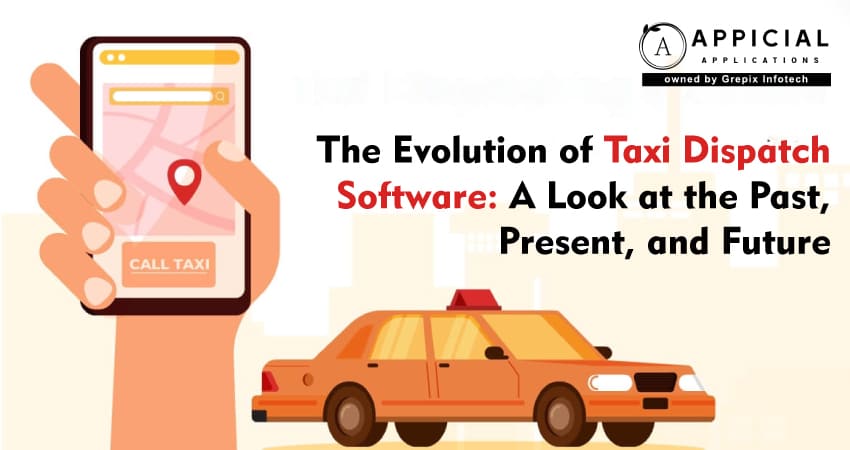
The Evolution of Taxi Dispatch Software: A Look at the Past, Present, and Future
The taxi industry has undergone significant transformations over the past few decades, primarily driven by advanced technology. Central to this evolution is taxi dispatch software, which has revolutionized how taxi services operate, enhancing efficiency, reliability, and customer satisfaction. This blog delves into the journey of taxi dispatch systems from their rudimentary beginnings to the sophisticated platforms we see today and explores what the future holds for this indispensable component of urban transportation.
The evolution of taxi dispatch software from simple, manual call-and-dispatch systems to today’s complex, integrated, and data-driven platforms illustrates the rapid pace of technological change. As we look to the future, continuous innovations in AI, autonomous vehicles, and user interface design are set to further transform how taxi services operate. By embracing these changes, the taxi industry can look forward to a smarter, more efficient, and customer-focused future.
Taxi dispatch software has significantly transformed the transportation industry over the past few decades. From the rudimentary systems of the past to the sophisticated, AI-driven platforms of today, the evolution of this software reflects broader technological advancements and changing consumer expectations. This comprehensive analysis explores the historical development, current trends, and future projections for taxi dispatch software.
Taxi dispatch software has transformed the transportation industry by evolving from simple, manual systems to advanced, AI-driven platforms. Initially reliant on call centers and manual tracking, dispatch systems have integrated technologies like GPS, real-time data, and mobile applications, enhancing operational efficiency and customer satisfaction. Modern dispatch software utilizes data analytics and machine learning to optimize routing and demand prediction. Looking forward, the integration of autonomous vehicles, increased customization, environmental considerations, and integration with urban transport systems are poised to further revolutionize the industry. This ongoing evolution underscores a shift towards more efficient, customer-focused services that align with technological advancements and changing consumer expectations.
The Past: Early Days of Taxi Dispatch
Before the digital age, taxi dispatching was a labor-intensive process that relied heavily on human coordination and rudimentary communication tools.
1 Manual Dispatch Methods
In the early 20th century, taxi services were coordinated through physical stands or queues where drivers would wait for passengers. Dispatchers used manual methods such as chalkboards or paper logs to track taxi availability and assign rides. This system was inherently inefficient, prone to errors, and incapable of handling high volumes of requests.
2 Radio Communication
The introduction of two-way radio systems in the 1940s marked a significant improvement. Dispatchers could now communicate directly with drivers, assigning jobs in real time and responding more swiftly to customer requests. While this reduced some delays, it was still a centralized system that depended on the dispatcher’s ability to manage communications effectively. Miscommunications were common, and the system could not optimize routes or consider real-time traffic conditions.
The Present: Advances and Integration
Today, taxi dispatch software has evolved into highly sophisticated platforms that integrate various technologies to improve service delivery and efficiency. Modern dispatch systems utilize GPS technology, real-time data processing, and mobile communications, vastly improving upon the early computer-assisted models. These platforms can track the location of taxis in real time, predict demand in different areas, and automatically dispatch taxis to where they are needed most.
1 Integration with Mobile Technology
The rise of smartphones has been a significant driver in the evolution of taxi dispatch software. Mobile apps now allow customers to book taxis with a few taps on their devices. These apps provide users with the convenience of seeing the location of their ride, the profile of the driver, and the estimated arrival time. For drivers, apps offer the advantage of receiving ride requests directly on their smartphones, along with route guidance and customer information.
2 Rise of GPS and Mobile Technology
The late 1990s and early 2000s saw significant technological advancements that profoundly impacted taxi dispatch systems.
Real-time Tracking
Global Positioning System (GPS) technology allowed for real-time tracking of vehicles. Dispatch software integrated with GPS could now:
- Monitor Driver Locations: Know exactly where each taxi is at any given moment.
- Optimize Dispatching: Assign the nearest available driver to a passenger.
- Improve Safety: Provide route histories and monitor for any anomalies.
Also Read: Role of Dynamic Pricing in Maximizing Profits for Taxi Apps
The Future: Trends Shaping Tomorrow
Looking forward, the future of taxi dispatch software is likely to be shaped by several emerging trends, each driven by ongoing advancements in technology and shifts in consumer behavior.
1 Autonomous Vehicles
The potential integration of autonomous vehicles into taxi fleets is perhaps one of the most intriguing prospects. As self-driving technology advances, taxi dispatch software will need to evolve to manage these new types of vehicles. Dispatch systems of the future will require algorithms capable of integrating human-driven and autonomous cars, assigning them to routes and rides in a way that maximizes efficiency and safety.
2 Greater Customization and User Experience
As consumer expectations continue to rise, future dispatch systems will likely offer greater customization for users. This could include choosing the type of vehicle, specific amenities, or even preferred driver attributes. Enhancing user experience will remain a priority, with more interactive and user-friendly interfaces.
3 Environmental Considerations
Environmental impact is becoming a crucial factor in the design and operation of taxi services. Future taxi dispatch software may include features that optimize for lower emissions, such as suggesting hybrid or electric vehicles when available and optimizing routes to reduce fuel consumption.
4 Integration with Urban Transportation Systems
As cities grow and seek more sustainable transportation solutions, taxi dispatch software could become integrated with broader urban transport systems. This integration would allow for seamless travel across multiple modes of transport, from taxis to public transit, enhancing efficiency and reducing urban congestion.
Conclusion
The evolution of taxi dispatch software, as exemplified by platforms like Appicial a leading taxi app development company, demonstrates a significant technological leap from its early manual and radio-based systems to today's sophisticated, integrated solutions. By harnessing the power of GPS, mobile technology, data analytics, and machine learning, these platforms have not only streamlined operations but also dramatically enhanced the responsiveness and efficiency of taxi services. Looking ahead, with potential advancements such as the integration of autonomous vehicles, increased customization, and a greater focus on environmental sustainability, the future of taxi dispatch software appears poised to continue transforming the urban transportation landscape. Taxi companies that continue to innovate and adapt to these evolving technologies will likely lead the charge toward a more efficient, user-friendly, and environmentally conscious transportation ecosystem.
Looking out to start your own venture like Uber? Try out our HireMe Taxi Uber Clone, the easiest way to kick-start your taxi business.Author's Bio

Vinay Jain is the Founder at Grepix Infotech and brings over 12 years of entrepreneurial experience. His focus revolves around software & business development and customer satisfaction.
Back to blog list






